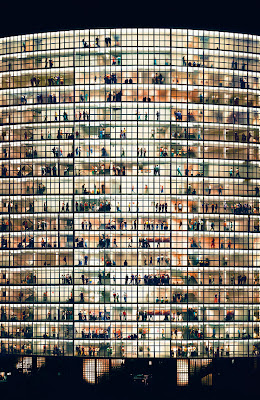Rutt Blees-Luxemburg
Presenting a hauntingly beautiful impression of some of London’s most familiar landmarks.
‘the 5 x 4 camera is the opposite of what the street photographer would use. It requires slowness and concentration and the exposures are long. Ten, fifteen, twenty minutes. So it’s another kind of street photography. Or maybe ‘street’ isn’t even important. ‘Public’ photography is better.’
Her photographs are of streets or contain streets. In 'Liebeslied' photographs show kind of
Her ealy works were about great heights and the monumentality of the build city.
Recent work are more intimity. There is an attention to another experience of the public, the small theatrical spaces and gestures.
Difference between Bless-Luxemburg and Wentworht and Lutter is that her photographs are almost the opposite of street photography which we associate with bright daylight, people, grabbed chance instants and rapidity. Her images shows emptiness...
Richard Wentworth
(Sculptor and photographer, urban explorer, walker and talker)
All Wentworth pictures are basically snapshots taken on the streets. Pictures of urban life where the things change or the things that never do.
Shotckholm: Bottle cap as an ashtray, sparing the green tablecloth. Is this action inspired by the presence of the bottle cap, the manners of the smoker, or a completely unthinking gesture? Wentworth pointed out the sexual connotations of the red hot cigarette tip plunged into the open bottle cap, complicating things further. Wentworth is drawn to the poetry as much as the prosaic reality of his images.
Vera Lutter
Vera Lutters photography is inspired by the city’s presence, light, and architecture.
Her art works (silver gelatin prints) are negatives made by transforming room into a camera obscura. Because of ethereal platinum tones her photographs looks quite melancholic.
Using just simple photosensitive paper she had changed popular landscapes, such the Manhattan, for abstract spaces never seen before.
Her art works (silver gelatin prints) are negatives made by transforming room into a camera obscura. Because of ethereal platinum tones her photographs looks quite melancholic.
Using just simple photosensitive paper she had changed popular landscapes, such the Manhattan, for abstract spaces never seen before.
In her works, she focused on industrial sites that pertain to transportation and fabrication.
‘333 North Michigan Avenue, Chicago, IL’, 2001
The Museum of Contemporary Photography commissioned Lutter in 2001 to turn rooms in Chicago office buildings into camera obscuras and photograph Chicago’s downtown. Chicago’s buildings have long been photographed – this vertical city on the prairie, with its blocks of abstract grids, has held great attractions for the camera – and Lutter’s pictures, with their sweeping verticals and repeated rectangles, play up these aspects. The Chicago photographs show the presence of old and new buildings, compressed into a grid of overlapping planes.
Lutter uses the camera obscura to render in massive form images that serve as faithful transcriptions of immense architectural spaces.
Similarity is that all three photographers show the city from other point of view. Unseen or just lost in the same second as seen or just ignored. But all of them have different message to tell, intimacy, or kind of poetry, or evolution of the city.
There are three different techniques, such as camera obscura or 5x4 camera. Three different concepts which are talking about the city in many different ways.














































